The Importance of Choosing the Right Caster Size
Choosing the right caster size is crucial for the proper functioning of any application that uses casters. The wrong size of casters can result in a variety of problems such as excessive wear and tear on the caster wheels, damage to the flooring or surface, reduced maneuverability, decreased load capacity, and even safety hazards.
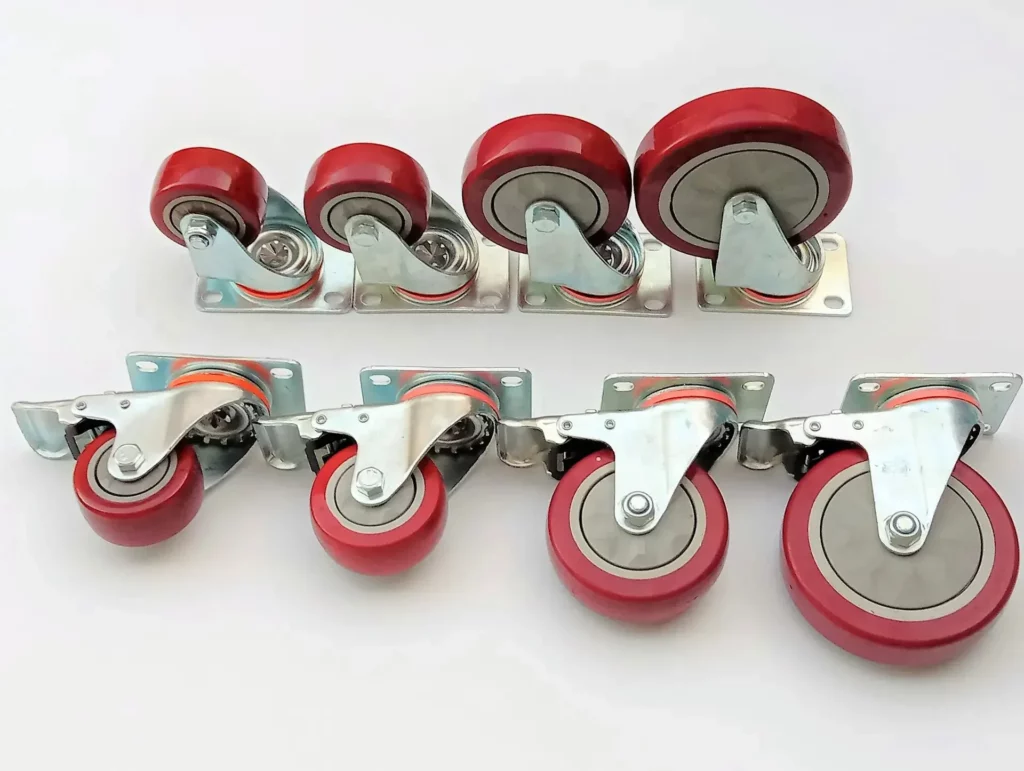
For example, if you select casters that are too small for the load you are carrying, they may not be able to support the weight of the load, resulting in damage to the casters or even the load itself. On the other hand, if you choose casters that are too large, they may not fit into the available space or may not be able to turn and maneuver properly, leading to difficulty in moving the load.
Furthermore, selecting the right caster size can also help to increase efficiency and productivity by making it easier to move heavy loads from one place to another. By choosing the right caster size, you can reduce the amount of effort needed to move the load, increase the speed and maneuverability of the application, and reduce the risk of accidents or injuries.
Factors to Consider When Choosing Caster Size
1. Load Capacity
The load capacity of a caster is one of the most important factors to consider when selecting the appropriate caster size. The load capacity refers to the maximum weight that a caster can support while maintaining proper functionality and safety. If a caster is overloaded beyond its capacity, it may fail, causing damage to the load, the caster, or the equipment.
When calculating the load capacity of a caster, several factors need to be taken into account. The weight of the load is the primary consideration, but other factors such as the number of casters in use, the position of the load, and the type of application must also be considered. Learn how to calculate the load capacity of the casters you need.
It’s essential to determine the total weight of the load and divide it by the number of casters that will be used to support it. This will provide an estimate of the load capacity required for each caster. In addition, the position of the load on the caster also affects the load capacity. If the load is not evenly distributed across all the casters, some casters may be supporting more weight than others, increasing the risk of failure.
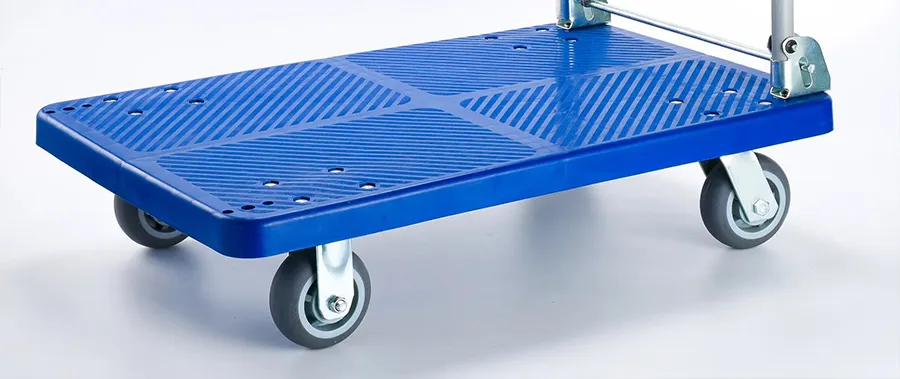
What are the classifications of the load capacity of casters?
Low-duty casters, also known as light-duty casters, are designed to support lighter loads and are typically used in applications that require infrequent movement. They usually have a load capacity of up to 300 pounds per caster and are commonly used for furniture, carts, and dollies.
Medium-duty casters are designed to support moderately heavy loads and are commonly used in applications that require frequent movement. They usually have a load capacity of up to 1,000 pounds per caster and are often used in industrial settings, such as manufacturing plants, hospitals, and warehouses.
Heavy-duty casters are designed to support extremely heavy loads and are used in applications that require frequent movement of heavy loads. They usually have a load capacity of up to 20,000 pounds per caster and are commonly used in applications such as aerospace, automotive, and military equipment, as well as heavy machinery and industrial equipment.
The load capacity of a caster is not the only factor that determines its classification as low-duty, medium-duty, or heavy-duty. Other factors such as the caster’s size, construction, and material also play a role in its classification. It’s essential to choose the appropriate caster size and classification based on the load and requirements of the specific application to ensure proper functionality and safety.
2. Floor Type
The type of flooring on which casters will be used is an important factor to consider when selecting the appropriate caster size. Different types of flooring have different levels of resistance and smoothness, which can affect the maneuverability and performance of casters. Choosing the wrong caster size for the flooring type can result in damage to the flooring, reduced load capacity, and decreased maneuverability.
For example, soft floorings, such as carpets or rubber mats, can create resistance against the casters, making them more difficult to move. Using too small casters on soft flooring can also result in the casters sinking into the flooring, making it difficult to move the load and potentially causing damage to the flooring.

On the other hand, hard flooring, such as concrete or tile, may require casters with a larger diameter to prevent them from damaging the flooring. If the caster size is too small, it can cause the wheels to dig into the flooring, resulting in scratches and dents.
Additionally, the smoothness of the flooring can also affect caster performance. Uneven or rough flooring can make it difficult for casters to maneuver, causing the load to move in unpredictable directions. In such cases, larger diameter casters may be required to ensure smooth movement and maneuverability.
3. Speed and Maneuverability
The speed and maneuverability of the application are important factors to consider when selecting the appropriate caster size. The caster size and design can significantly affect the speed and maneuverability of the equipment or load, which can impact productivity and safety in the workplace.
Smaller caster sizes may be preferred for applications requiring frequent movements and high speeds, such as in manufacturing plants or warehouses. Smaller caster sizes allow greater maneuverability and more precise movements in tight spaces. They also offer quicker acceleration and deceleration, which can increase productivity and efficiency.
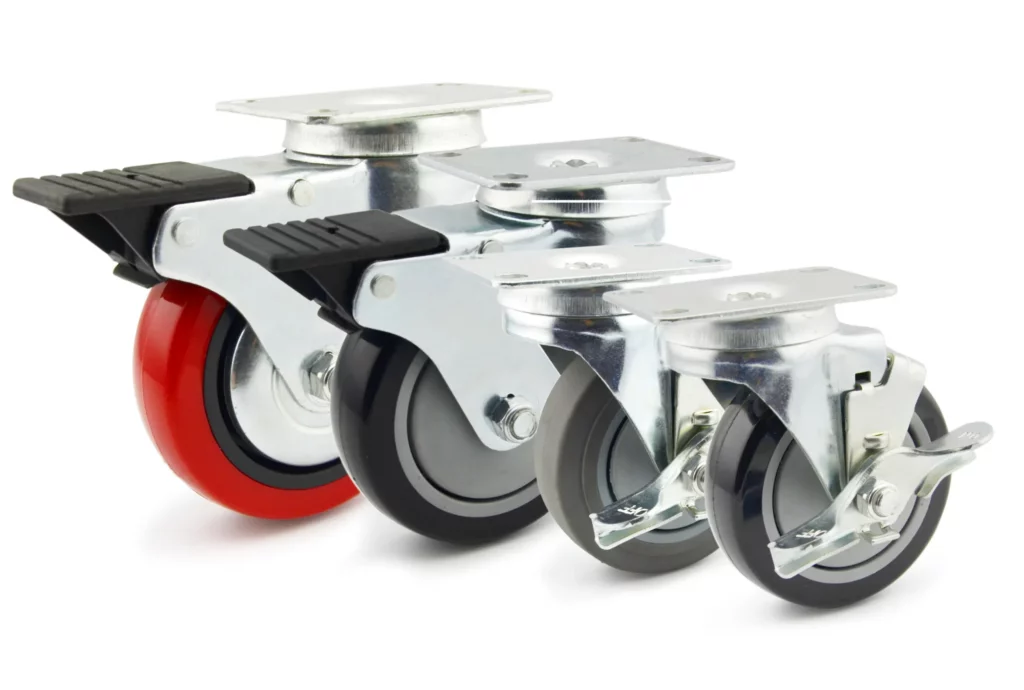
However, smaller caster sizes may not be appropriate for applications that require heavy loads or more stability, as they may not provide adequate load capacity or stability at high speeds. In such cases, larger caster sizes may be necessary to ensure proper stability and load capacity. Larger caster sizes may be preferred for applications requiring frequent turning and maneuvering, such as in hospitals or offices. Larger caster sizes provide greater stability and weight distribution, reducing the risk of tipping or losing control of the load. They also offer smoother movement and greater shock absorption, increasing safety and reducing the risk of damage to the load or equipment.
4. Single Wheel vs. Dual Wheel
Single and dual wheel casters are two common types of casters, each with its own unique features and benefits.
Single-wheel casters, as the name suggests, have a single wheel attached to the caster frame. They are commonly used on lighter loads, such as carts or dollies, or in situations where maneuverability is essential. Single-wheel casters are available in a variety of sizes, typically ranging from 1 inch to 6 inches in diameter.
Dual wheel casters, on the other hand, have two wheels attached to the caster frame. They are commonly used on heavier loads, such as industrial equipment or machinery, where increased load capacity is required. Dual wheel casters are available in a variety of sizes, typically ranging from 2 inches to 12 inches in diameter.
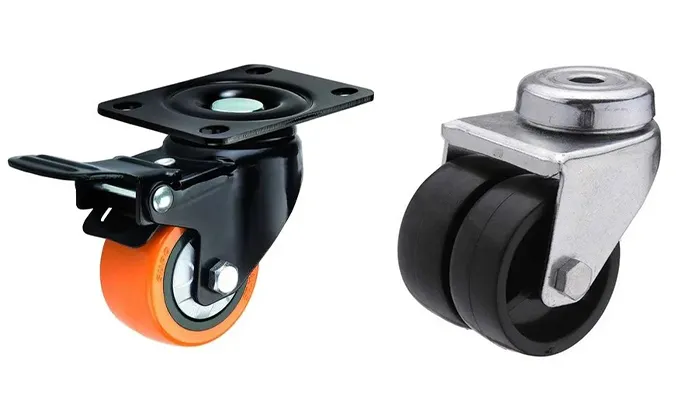
When it comes to caster size, the main difference between single and dual-wheel casters is load capacity. Dual-wheel casters have a higher load capacity than single-wheel casters, which means they can support heavier loads without compromising stability or maneuverability.
Additionally, the size of the wheels on single and dual-wheel casters can also affect load capacity. Larger wheels distribute weight more evenly and provide better stability, which means they can support heavier loads than smaller wheels. When selecting the appropriate caster size for either type, it’s important to consider the load capacity, flooring type, and speed and maneuverability of the equipment. Dual-wheel casters may require larger diameters to ensure proper load capacity and stability, while single-wheel casters may require smaller diameters for increased maneuverability.
5. Wheel Material
The material of the wheel is an important consideration when choosing the appropriate caster size. The choice of wheel material depends on several factors, including the load capacity, flooring type, and the environment in which the caster will be used.
Here are some common wheel materials and how they can affect caster size:
Polyurethane: Polyurethane wheels are a popular choice for their durability and resistance to abrasion. They can support heavy loads and are suitable for a wide range of flooring types, including concrete, wood, and tile. Polyurethane wheels come in a variety of sizes, typically ranging from 2 inches to 12 inches in diameter.
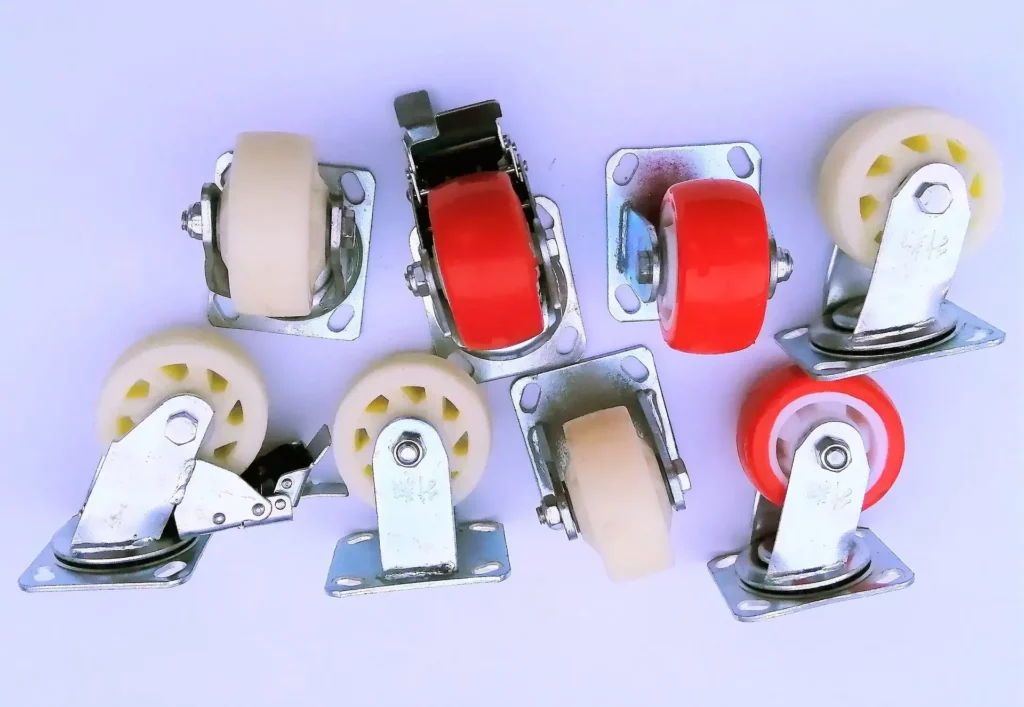
Rubber: Rubber wheels are a good choice for applications that require good traction and shock absorption. They are suitable for indoor and outdoor use and are ideal for use on uneven or rough surfaces. Rubber wheels come in a variety of sizes, typically ranging from 2 inches to 10 inches in diameter.
Nylon: Nylon wheels are known for their strength and durability. They are resistant to chemicals, oils, and grease and are suitable for use in wet or harsh environments. Nylon wheels come in a variety of sizes, typically ranging from 2 inches to 12 inches in diameter.
Steel: Steel wheels are strong and durable, making them a good choice for heavy-duty applications. They are suitable for use on concrete or other hard surfaces, but may not be ideal for use on softer surfaces, as they can leave marks. Steel wheels come in a variety of sizes, typically ranging from 3 inches to 12 inches in diameter.
#Learn more about the introduction of different material characteristics of casters
6. Installation height of casters
The installation height of the casters will affect the height of the center of gravity of the equipment. For example, for machinery and equipment, a lower center of gravity will make the movement of the machine safer. At this time, small-sized low-center-of-gravity casters may be a good choice; in addition, in some height-limited spaces, it is more necessary to choose casters with a suitable installation height.
When selecting the appropriate caster size for different wheel materials, it’s important to consider the load capacity and flooring type. For example, softer wheel materials like rubber may require larger diameters to support heavier loads, while harder wheel materials like steel may require smaller diameters to prevent damage to the flooring surface.
How Do I Choose the Right Caster Size?
Choosing the right caster size is crucial for ensuring proper functionality, load capacity, and safety in the workplace. Here is a step-by-step guide on how to choose the appropriate caster size based on the factors we’ve discussed:
1. Determine load capacity: The first step in choosing the right caster size is to determine the load capacity. Calculate the weight of the equipment or load that will be placed on the caster. Make sure to account for any potential increases in weight in the future.
2. Determine the installation height: Measure or calculate the range of the installation height of the casters you need to ensure that the installation height of the casters meets the actual needs.
3. Determine flooring type: Consider the type of flooring the caster will be used on. This will help determine the appropriate wheel material and size. For example, softer flooring types may require larger wheel diameters to prevent damage.
4. Determine speed and maneuverability: Consider the speed and maneuverability required for the equipment. If the equipment needs to move quickly or turn frequently, smaller caster sizes may be necessary to ensure proper maneuverability.
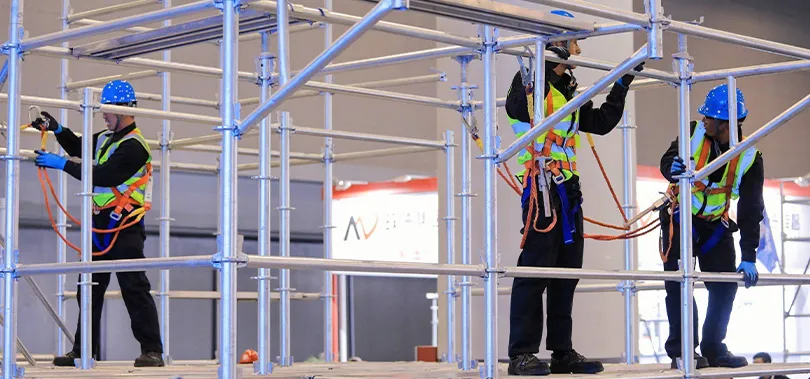
5. Determine duty rating: Determine the duty rating needed for the caster. Low-duty casters are suitable for light loads and infrequent use, while heavy-duty casters are suitable for heavier loads and frequent use.
6. Determine caster type: Consider the type of caster needed. Swivel casters provide greater maneuverability but may require larger diameters to support heavier loads. Rigid casters are less maneuverable but provide greater stability and load capacity.
7. Determine wheel material: Consider the appropriate wheel material based on the flooring type and load capacity. Softer wheel materials may require larger diameters to support heavier loads, while harder wheel materials may require smaller diameters to prevent damage to the flooring surface.
8. Choose the appropriate caster size: Once you have determined the load capacity, flooring type, speed, maneuverability, duty rating, caster type, and wheel material, you can choose the appropriate caster size.
Make sure to select a caster size that can support the load capacity while providing proper maneuverability and stability. By following these steps, you can choose the appropriate caster size for your specific application and load requirements, ensuring proper functionality, load capacity, and safety in the workplace.
You can also consult Bullcaster’s caster experts, we can provide you with free caster selection consultation.
خاتمة
Choosing the right caster size is important for several reasons. It ensures proper functionality and maneuverability, prevents damage to flooring surfaces, and supports the load capacity of the equipment. Selecting the wrong caster size can lead to safety hazards, decreased efficiency, and costly repairs or replacements.
By taking into consideration factors such as load capacity, flooring type, speed and maneuverability, duty rating, caster type, and wheel material, you can choose the appropriate caster size for your specific application, ensuring proper functionality, load capacity, and safety in the workplace.
Bullcaster is committed to providing high-quality casters for casters all over the world, you can consult us for quotations of various casters.


